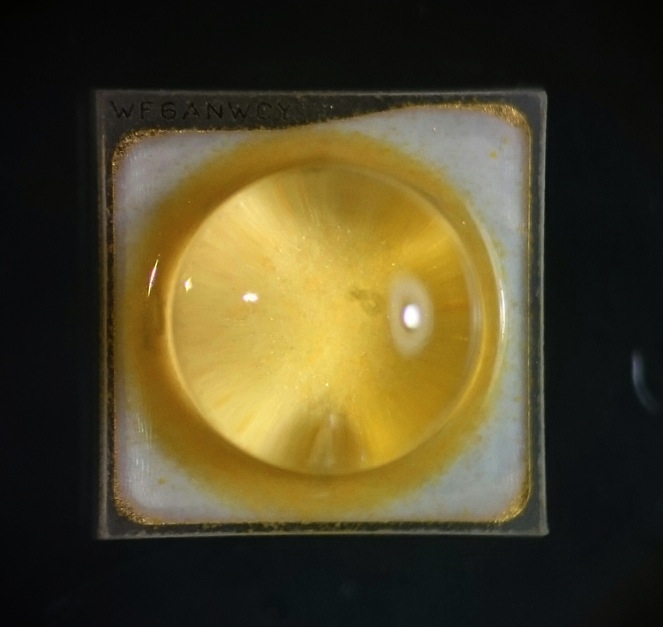
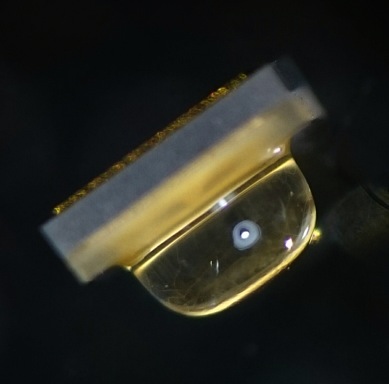
A few weeks ago Osram announced a lowering of voltage for their Oslon Square led, and that in fact production had started september last year already. I did a test on an Oslon Square led in 2013 and was pleasantly surprised by the performance, up to 4A it appeared to work as well as a XP-G2 in fact, but since then I have never seen it in a flashlight.
So I wanted to test the new Oslon Square now. I was looking for the new Oslon Square on rs-online, but the product codes that Osram uses were and still are a mystery to me, and there's nowhere to go for an explanation. So which led was the new one with the lower voltage? I looked up voltages in some datasheets and many probably were the new led. What does not help is that rs-online does not update the images very well, the die of the new Oslon Square has a new appearance. So finally I bought the minimum amount (5) of an Oslon Square led that was labeled 'new' on the site, the GW CSSRM1.CC-MQMS-5L7N-1-700-R18. And it is an interesting led indeed, 4000K and 92CRI, a direct challenge for the Nichia high CRI leds. And personally I like 4000K better than the 5000K of the Nichia219b 92CRI.
The test.
The tests that I have done compare this Oslon, the Nichia219b 92CRI, and a cool white XP-G2 R5. The XP-G2 R5 is not the best bin anymore, and is not the newest batch, but you will get the idea and the most interesting part IMO is the voltage comparison and at which current the output peaks. (you can not expect a 4000K 92CRI led to have the output of a cool white so that would be comparing apples and pears).
The leds were reflowed onto 16mm Noctigons (the two boards with numbers on them were used in another test, hence the numbers). Oslon leds do not fit perfectly on a XP-board (the solder pad lay-out is a bit smaller), and therefore the led does not suck tight onto the board like a XP led. Consequently the solder layer is thicker. I do not worry much about that because in another test I did not find significant heatpath problems caused by thick solder layers.
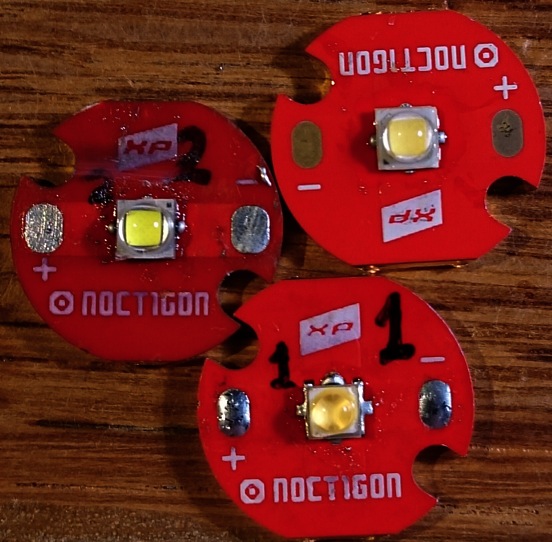
The test was done the same way as I did my XP-L tests, for a detailed description of the set-up see over there. The only difference is that I used my big integrating sphere for this test, but that should not matter much for the results. The light output unit is the 'djozz-lumen', a unit that at least is higly comparable to results in my other tests, and that I think is somewhat near 'real lumens'. But an absolute and official calibration of my sphere still has to happen (when I win the lottery). I stopped the Nichia and XP-G2 test at 6A because I wanted to salvage the emitters, for the Oslon Square I went on until it died (at a bit over 8A). Here is the graph:
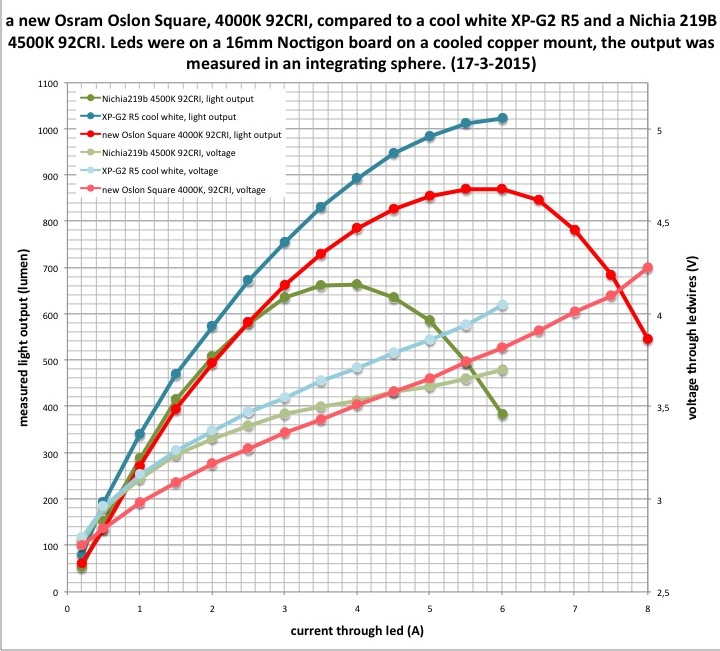
Observations from the graph:
*the new Oslon Square performs better than the Nichia: up to 4A the voltage is lower, over 2.5A the output is better, and it peaks higher and at a higher current.
* the voltage of the new Oslon Square is significantly lower than the XP-G2, about 0.2V over the whole current range. Very nice for the use in single cell flashlights, and for efficiency of course.
*the Oslon Square died when I turned the amperage from 8 to 8.5A, that is almost the crash amperage of the XP-G2, this is a tough led! Noteworthy is that the Nichia survived 6A (during my last test of the Nichia219b I stopped at 5A), and performed equally well after that.
* if I loosely extrapolate these Oslon Square results to a cool white emitter, I think it overtakes the XP-G2 R5 in output (and at a 0.2 lower voltage!), and perhaps even the higher XP-G2 bins?(wishful thinking). At least with these lower voltages I think the XP-G2 will be outperformed by the new Oslon Square in high current single cell flashlights, like DD-FET-driver triple led builds. A new test of a cool white Oslon Square against a top bin XP-G2 would give more information, but I am not planning on that myself.
A mod with this led.
And now for the difficult part, the tint judgement. 4000K 92CRI should give extremely pleasant light :-) Objective judgement is difficult because I have no equipment to measure tint and CRI, it will be a subjective observation. For this the led needed to be inside a flashlight. I had a Lucky Sun EDC mini20 flashlight still unmodded, this would be the candidate: pocketable and a bit throwy, the low voltage of the Oslon should get the max out of a 16340 battery.


The mod will involve this new Oslon Square 4000K 92CRI, a FET-modded AK-47 direct driver, and a tailspring bypass. First the spring. As others have noted, there is no way to get to the tail section of this flashlight, too tight, no grip and glued. So I had to do the tail spring bypass (with 18AWG silicone wire) through the battery tube, imagine soldering through a tube? :sick:
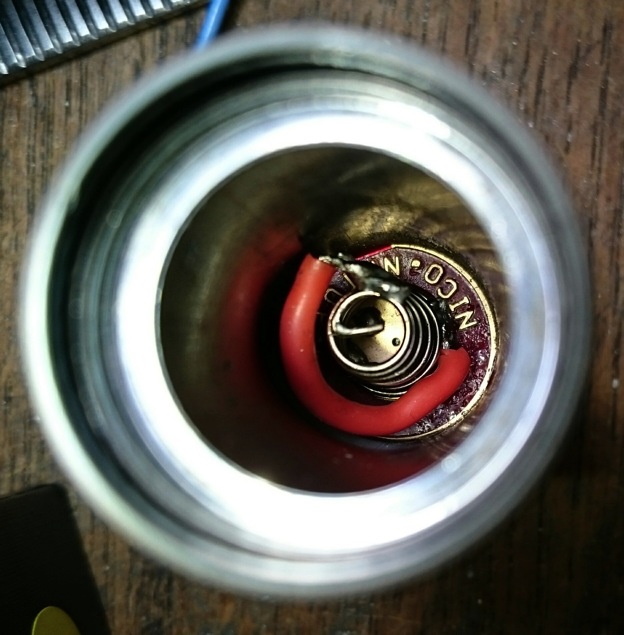
Is this through-tube spring bypassing a BLF-first? :-)
The Lucky Sun driver that came out looks like a pretty nice direct drive FET-driver too (2 parallel little FETS with 0.5 Ohms of current limiting):

Anyway, it was replaced by this type, as described in this thread, I used the FET from Ebay:
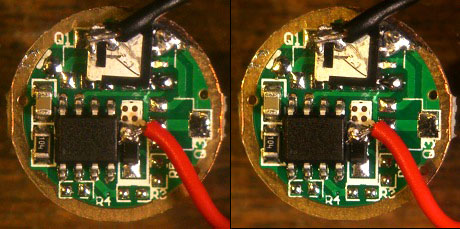 (stereo image)
(stereo image)
I used short 2cm 22AWG ledwires. This flashlight has no pill, the ledboard sits on a shelf that is one part with the body. That shelf is anodised and although I have not seen direct tests yet that prove that that is detrimental for the heat path, I did some sanding on it to thin the anodising a bit. The shelf has also a shallow dip in the middle, I worried less about that. The 16mm ledboard fitted snugly in the head and so did the reflector, so centering the led with a special XP centering piece was not neccessary, I used the stock one (the Oslon is smaller than a XP led, so even a XP centering piece would not have worked). As usual, the solder blobs had to be as flat and as far to the outside of the board as possible to prevent shorting with the reflector. The result:
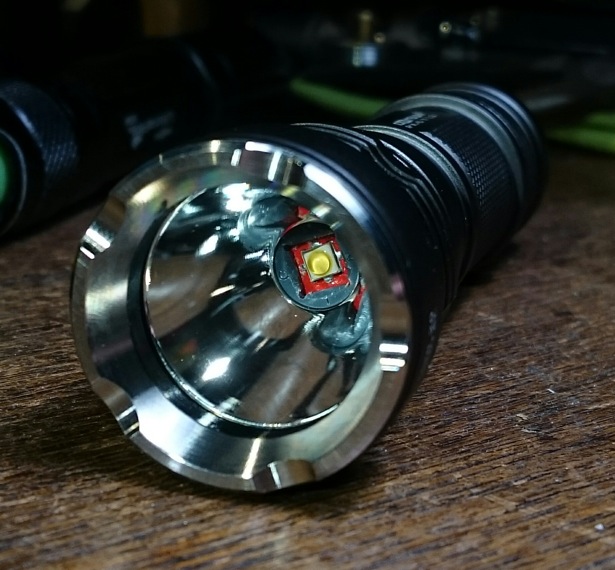
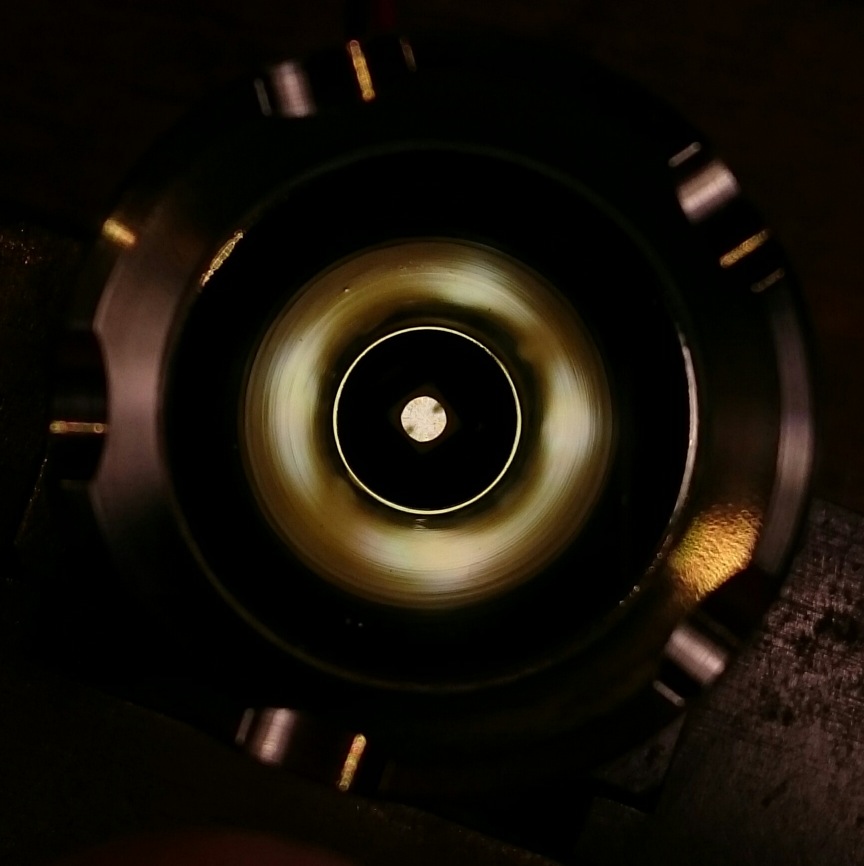
I tried to judge the tint for a while, also comparing it with other flashlights: it is indeed very pleasant and you can see it reproduces colours very well, wood tints and foods looks very natural, it is more 'green' than both the Nichia 219A 92CRI and the Nichia 219B 92CRI, the Nichia's look more 'rosy'. But compared to my ugly green Olight S20 it is very nice and rosy again :-) It is a matter of taste if you like Nichia's rosy tints better or this Oslon tint.
BTW, if you ask why I do not show comparing tint shots: it is my longterm experience that in pictures real tints are not at all reproduced well, it would confuse more than help the comparison.
Beamshots
Two white wall shots from 2 meters, daylight setting on my phone camera, first normal exposure, the second underexposed to show the real spotsize:


A very smooth throwy beam in principle, but that ring has to go sometime, by blackening the inside of the stainless steel bezel.
Outside, Trusty Test Tree in winter at 23 meters. Left is the control. The right picture shows this LuckySun mod on the right, on the left (for fun) a dedomed XP-E2 modded Cofly KX-H10 zoomie (43kcd) :
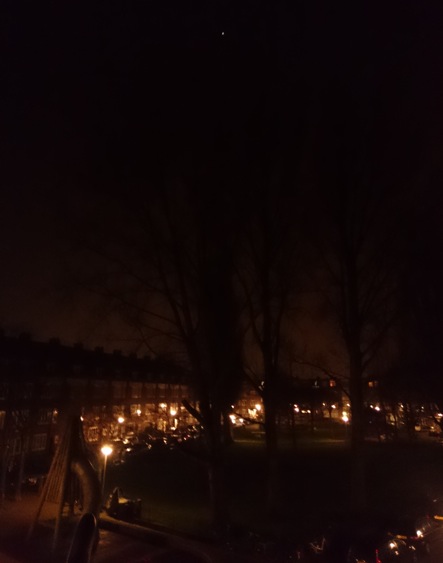
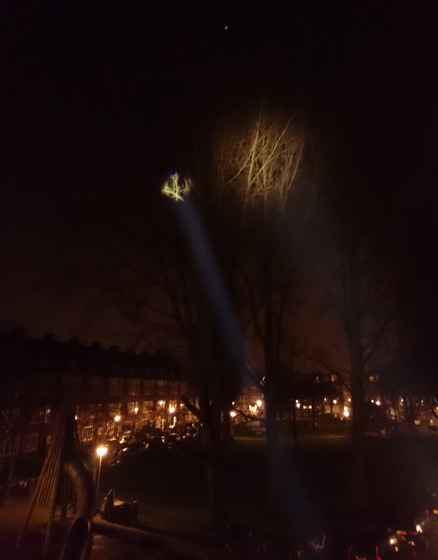
Numbers (on a freshly charged AW 16340 IMR battery) :
*Light output on high setting: 615 lumen at start, 472 lumen after 30 seconds (23% drop in 30 seconds  : the heatsinking of this mod appears not great, have to look into that again)
: the heatsinking of this mod appears not great, have to look into that again)
*Throw at high setting, measured with after 30 seconds: 12.8 klux@1 meter. Now that is nice for a small pocket flashlight, especially in 4000K 92CRI :-)
*current at the tail (bypassing the switch): 4.47A at start, 3.93A after 30 seconds (12% current drop in 30 seconds, so half of the light output drop is a heating-up effect, 11% heat sag in 30 seconds may not be that bad for a small led driven at 16W after all..)
I have to improve the heatpath near the ledboard sometime, but I think this mod worked out very nicely :-)
Conclusion:
It is time for Cree to come out with a 'new' XP-G2, it is getting outperformed by other leds now. And for the tint snobs, this new Osram Oslon Square 4000K 92CRI is a great addition to what is out there: more output in 92CRI. I have three of these emitter leftover and I think they are going as a triple into a direct driven EagleEyeX6 one of these days, I hope to get 1800 lumen of lovely tinted light.
Thanks for reading :-)
